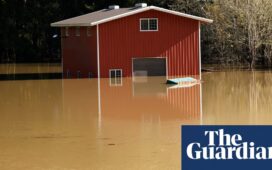Hurricane Dorian, now a Category 3 storm, remained stalled over the Bahamas early Tuesday, pummeling the islands with unrelenting rain and winds as the United States waited to see what destructive path it would take.
The storm, one of the strongest on record in the Atlantic, remained stationary just north of Grand Bahama Island, delivering 120 mile-per-hour winds and ceaseless downpours that have flooded neighborhoods, destroyed homes and killed at least five people. The hurricane was expected to finally move northwest early Tuesday before turning north near Florida’s eastern coast by Wednesday, according to the National Weather Service.
It is highly unusual for a storm of Dorian’s magnitude to halt and hover over land, bringing what officials fear could be catastrophic damage to the Caribbean islands. It crawled along at just one m.p.h. on Monday before all but standing still, moving just 14 miles from 8 a.m. to 7 p.m.
“Dorian won’t budge,” the National Weather Service said in an update at 1 a.m. Eastern time Tuesday.
Officials in the Bahamas had not yet determined the full scope of the damage there, with the relentless rains and winds making it difficult to reach many of the smaller islands struck by the hurricane. The storm was expected to continue to pound Grand Bahama Island through Tuesday morning, and rescuers said they might not be able to send teams until as late as Wednesday.
Attention will soon turn to the United States, with the possibility of severe damage over a broad swath of the East Coast. A hurricane warning extended across 240 miles of the Florida coast, some coastal residents in Florida, Georgia and the Carolinas were ordered to evacuate, and the governor of Virginia declared a state of emergency.
The National Weather Service predicted the hurricane would move “dangerously close” to Florida’s eastern shores late Tuesday through Wednesday evening. It will move near the Georgia and South Carolina coasts Wednesday night and Thursday, then pass by the North Carolina coast late Thursday and Friday, according to a forecast released Tuesday morning.
Forecasters moved the “cone of uncertainty” eastward on Monday, but even a small deviation could thrust the storm onto the coast. And heavy rains and winds are all but certain to thrash the coast, even if the eye does not cross onto land.
“Although gradual weakening is forecast, Dorian is expected to remain a powerful hurricane during the next couple of days,” the Weather Service said on Tuesday.
The storm hit the Bahamas as a Category 5 hurricane, and thousands of homes on the Abaco Islands, east of Grand Bahama, were believed to have been damaged or destroyed.

